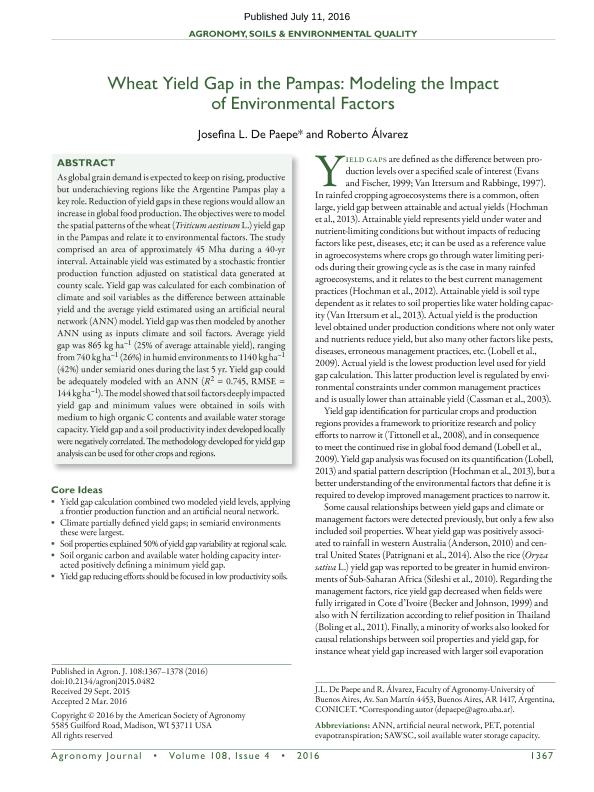Mostrar el registro sencillo del ítem
dc.contributor.author
de Paepe, Josefina

dc.contributor.author
Alvarez, Roberto

dc.date.available
2018-07-05T21:05:37Z
dc.date.issued
2016-07
dc.identifier.citation
de Paepe, Josefina; Alvarez, Roberto; Wheat yield gap in the pampas: Modeling the impact of environmental factors; American Society of Agronomy; Agronomy Journal; 108; 4; 7-2016; 1367-1378
dc.identifier.issn
0002-1962
dc.identifier.uri
http://hdl.handle.net/11336/51448
dc.description.abstract
As global grain demand is expected to keep on rising, productive but underachieving regions like the Argentine Pampas play a key role. Reduction of yield gaps in these regions would allow an increase in global food production. The objectives were to model the spatial patterns of the wheat (Triticum aestivum L.) yield gap in the Pampas and relate it to environmental factors. The study comprised an area of approximately 45 Mha during a 40-yr interval. Attainable yield was estimated by a stochastic frontier production function adjusted on statistical data generated at county scale. Yield gap was calculated for each combination of climate and soil variables as the difference between attainable yield and the average yield estimated using an artificial neural network (ANN) model. Yield gap was then modeled by another ANN using as inputs climate and soil factors. Average yield gap was 865 kg ha–1(25% of average attainable yield), ranging from 740 kg ha–1 (26%) in humid environments to 1140 kg ha–1 (42%) under semiarid ones during the last 5 yr. Yield gap could be adequately modeled with an ANN (R2 = 0.745, RMSE = 144 kg ha–1). The model showed that soil factors deeply impacted yield gap and minimum values were obtained in soils with medium to high organic C contents and available water storage capacity. Yield gap and a soil productivity index developed locally were negatively correlated. The methodology developed for yield gap analysis can be used for other crops and regions.
dc.format
application/pdf
dc.language.iso
eng
dc.publisher
American Society of Agronomy

dc.rights
info:eu-repo/semantics/openAccess
dc.rights.uri
https://creativecommons.org/licenses/by-nc-sa/2.5/ar/
dc.subject
Trigo
dc.subject
Brecha de Rendimiento
dc.subject
Modelización
dc.subject.classification
Agricultura

dc.subject.classification
Agricultura, Silvicultura y Pesca

dc.subject.classification
CIENCIAS AGRÍCOLAS

dc.title
Wheat yield gap in the pampas: Modeling the impact of environmental factors
dc.type
info:eu-repo/semantics/article
dc.type
info:ar-repo/semantics/artículo
dc.type
info:eu-repo/semantics/publishedVersion
dc.date.updated
2018-06-22T14:36:03Z
dc.journal.volume
108
dc.journal.number
4
dc.journal.pagination
1367-1378
dc.journal.pais
Estados Unidos

dc.journal.ciudad
Madison
dc.description.fil
Fil: de Paepe, Josefina. Universidad de Buenos Aires. Facultad de Agronomía; Argentina. Consejo Nacional de Investigaciones Científicas y Técnicas. Oficina de Coordinación Administrativa Parque Centenario; Argentina
dc.description.fil
Fil: Alvarez, Roberto. Consejo Nacional de Investigaciones Científicas y Técnicas. Oficina de Coordinación Administrativa Parque Centenario; Argentina. Universidad de Buenos Aires. Facultad de Agronomía; Argentina
dc.journal.title
Agronomy Journal

dc.relation.alternativeid
info:eu-repo/semantics/altIdentifier/doi/http://dx.doi.org/10.2134/agronj2015.0482
dc.relation.alternativeid
info:eu-repo/semantics/altIdentifier/url/https://dl.sciencesocieties.org/publications/aj/abstracts/108/4/1367
Archivos asociados
